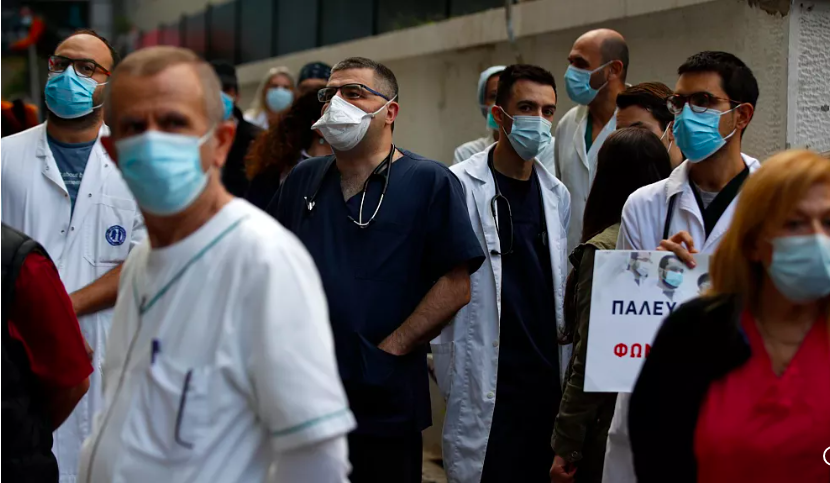COVID-19 Origins Still Unknown Without China’s Data, WHO Report Finds
Quote from Alex Bobby on June 30, 2025, 10:31 AM
Will We Ever Know How COVID-19 Began? WHO Says Not Without More Data from China
After more than three years of investigation, the World Health Organisation (WHO) has delivered an inconclusive final report on the origins of COVID-19—leaving one of the most urgent scientific questions of our time still unanswered. Despite extensive global efforts and mounting public pressure, the expert group tasked with uncovering the pandemic’s roots said that a definitive conclusion may never be possible without full cooperation and transparency from China.
At the heart of the mystery is a simple yet monumental question: How did SARS-CoV-2, the virus responsible for COVID-19, first infect humans? Was it through natural spillover from animals, or could it have been the result of a laboratory accident? According to the WHO, until more data is released—particularly from China—we may never know for sure.
Natural Origins Still the Leading Theory
Marietjie Venter, the chair of the WHO’s expert scientific advisory group, reiterated in a press briefing that most scientific evidence continues to support the theory that the virus originated in animals and jumped to humans—likely via an intermediary species such as raccoon dogs, civet cats, or bamboo rats.
This echoes the conclusions of the initial WHO investigation conducted in 2021, which determined that the virus likely spilled over from bats to humans. At the time, the organisation also stated that a laboratory leak was "extremely unlikely."
However, Venter emphasised that the group lacked access to critical data needed to fully explore or rule out the lab leak hypothesis. Despite repeated requests to the Chinese government for hundreds of genetic sequences, biosecurity records, and early case data, these materials were never shared.
A Divided Panel, an Incomplete Investigation
The WHO’s final report reveals the deep divisions within the scientific community. The 27-member expert group did not reach a consensus on the origins of COVID-19. In fact, one member resigned just before the release of the final report, and three others asked for their names to be removed—a rare and telling sign of internal disagreement and frustration.
Venter clarified that there is no evidence that the virus was engineered or deliberately manipulated in a lab. Nor is there proof that SARS-CoV-2 was circulating before December 2019, the month the outbreak was first identified in Wuhan, China.
“Until more scientific data becomes available, the origins of how SARS-CoV-2 entered human populations will remain inconclusive,” Venter said.
The Role of Politics and Data Withholding
The WHO’s inability to obtain key information from China has reignited criticism about the political barriers obstructing scientific inquiry. WHO Director-General Dr. Tedros Adhanom Ghebreyesus stated that uncovering the truth is not just a scientific duty, but a “moral imperative.”
With 20 million lives lost, an estimated $10 trillion in global economic damage, and billions of lives disrupted, the urgency of understanding how the pandemic began cannot be overstated.
“The world deserves answers,” Tedros said, stressing that failure to uncover the virus’s origins could leave humanity vulnerable to the next pandemic.
In 2023, an investigation by the Associated Press revealed that China froze early efforts to study the virus’s origins, both domestically and internationally. WHO, too, may have missed critical early opportunities to probe the situation before restrictions hardened.
Lab Leak Theory Still Unproven
While former U.S. President Donald Trump and several U.S. officials have long claimed that the virus escaped from a lab in China, no conclusive evidence has ever been provided. A U.S. intelligence assessment later concluded that there was insufficient proof to confirm or dismiss the lab leak hypothesis.
Chinese authorities have consistently rejected the theory, instead suggesting that the virus could have originated outside of China. Some officials even implied that the WHO should expand its investigation to other countries—diverting attention from China’s role in the early days of the outbreak.
The Scientific Hunt: Animals Under the Microscope
Despite geopolitical roadblocks, researchers continue to investigate the natural origins of the virus. In 2023, scientists narrowed their focus to a shortlist of animals that were likely intermediate hosts, including raccoon dogs, civet cats, and bamboo rats—species that were known to be sold in Wuhan’s Huanan Seafood Market, where many early cases were detected.
But without direct access to original market samples, case records, and environmental data from the early days of the outbreak, the findings remain circumstantial rather than conclusive.
Conclusion: A Mystery That May Never Be Solved
The WHO’s final report underscores a sobering truth: We may never know exactly how COVID-19 began. Scientific progress demands data, collaboration, and transparency—three things that have been in short supply since the earliest days of the pandemic.
Unless China releases more data and allows unfettered access to scientists, the origin of COVID-19 may remain one of the great unsolved mysteries of modern science. And with the health of future generations at stake, that’s a burden the world can’t afford to carry.
Meta Description (SEO):
A new WHO report finds that the origin of COVID-19 remains unknown due to lack of data from China. Experts say we may never know how the pandemic began without full transparency.

Will We Ever Know How COVID-19 Began? WHO Says Not Without More Data from China
After more than three years of investigation, the World Health Organisation (WHO) has delivered an inconclusive final report on the origins of COVID-19—leaving one of the most urgent scientific questions of our time still unanswered. Despite extensive global efforts and mounting public pressure, the expert group tasked with uncovering the pandemic’s roots said that a definitive conclusion may never be possible without full cooperation and transparency from China.
At the heart of the mystery is a simple yet monumental question: How did SARS-CoV-2, the virus responsible for COVID-19, first infect humans? Was it through natural spillover from animals, or could it have been the result of a laboratory accident? According to the WHO, until more data is released—particularly from China—we may never know for sure.
Register for Tekedia Mini-MBA edition 19 (Feb 9 – May 2, 2026): big discounts for early bird.
Tekedia AI in Business Masterclass opens registrations.
Join Tekedia Capital Syndicate and co-invest in great global startups.
Register for Tekedia AI Lab: From Technical Design to Deployment (next edition begins Jan 24 2026).
Natural Origins Still the Leading Theory
Marietjie Venter, the chair of the WHO’s expert scientific advisory group, reiterated in a press briefing that most scientific evidence continues to support the theory that the virus originated in animals and jumped to humans—likely via an intermediary species such as raccoon dogs, civet cats, or bamboo rats.
This echoes the conclusions of the initial WHO investigation conducted in 2021, which determined that the virus likely spilled over from bats to humans. At the time, the organisation also stated that a laboratory leak was "extremely unlikely."
However, Venter emphasised that the group lacked access to critical data needed to fully explore or rule out the lab leak hypothesis. Despite repeated requests to the Chinese government for hundreds of genetic sequences, biosecurity records, and early case data, these materials were never shared.
A Divided Panel, an Incomplete Investigation
The WHO’s final report reveals the deep divisions within the scientific community. The 27-member expert group did not reach a consensus on the origins of COVID-19. In fact, one member resigned just before the release of the final report, and three others asked for their names to be removed—a rare and telling sign of internal disagreement and frustration.
Venter clarified that there is no evidence that the virus was engineered or deliberately manipulated in a lab. Nor is there proof that SARS-CoV-2 was circulating before December 2019, the month the outbreak was first identified in Wuhan, China.
“Until more scientific data becomes available, the origins of how SARS-CoV-2 entered human populations will remain inconclusive,” Venter said.
The Role of Politics and Data Withholding
The WHO’s inability to obtain key information from China has reignited criticism about the political barriers obstructing scientific inquiry. WHO Director-General Dr. Tedros Adhanom Ghebreyesus stated that uncovering the truth is not just a scientific duty, but a “moral imperative.”
With 20 million lives lost, an estimated $10 trillion in global economic damage, and billions of lives disrupted, the urgency of understanding how the pandemic began cannot be overstated.
“The world deserves answers,” Tedros said, stressing that failure to uncover the virus’s origins could leave humanity vulnerable to the next pandemic.
In 2023, an investigation by the Associated Press revealed that China froze early efforts to study the virus’s origins, both domestically and internationally. WHO, too, may have missed critical early opportunities to probe the situation before restrictions hardened.
Lab Leak Theory Still Unproven
While former U.S. President Donald Trump and several U.S. officials have long claimed that the virus escaped from a lab in China, no conclusive evidence has ever been provided. A U.S. intelligence assessment later concluded that there was insufficient proof to confirm or dismiss the lab leak hypothesis.
Chinese authorities have consistently rejected the theory, instead suggesting that the virus could have originated outside of China. Some officials even implied that the WHO should expand its investigation to other countries—diverting attention from China’s role in the early days of the outbreak.
The Scientific Hunt: Animals Under the Microscope
Despite geopolitical roadblocks, researchers continue to investigate the natural origins of the virus. In 2023, scientists narrowed their focus to a shortlist of animals that were likely intermediate hosts, including raccoon dogs, civet cats, and bamboo rats—species that were known to be sold in Wuhan’s Huanan Seafood Market, where many early cases were detected.
But without direct access to original market samples, case records, and environmental data from the early days of the outbreak, the findings remain circumstantial rather than conclusive.
Conclusion: A Mystery That May Never Be Solved
The WHO’s final report underscores a sobering truth: We may never know exactly how COVID-19 began. Scientific progress demands data, collaboration, and transparency—three things that have been in short supply since the earliest days of the pandemic.
Unless China releases more data and allows unfettered access to scientists, the origin of COVID-19 may remain one of the great unsolved mysteries of modern science. And with the health of future generations at stake, that’s a burden the world can’t afford to carry.
Meta Description (SEO):
A new WHO report finds that the origin of COVID-19 remains unknown due to lack of data from China. Experts say we may never know how the pandemic began without full transparency.
Share this:
- Click to share on Facebook (Opens in new window) Facebook
- Click to share on X (Opens in new window) X
- Click to share on WhatsApp (Opens in new window) WhatsApp
- Click to share on LinkedIn (Opens in new window) LinkedIn
- Click to email a link to a friend (Opens in new window) Email
- Click to print (Opens in new window) Print



